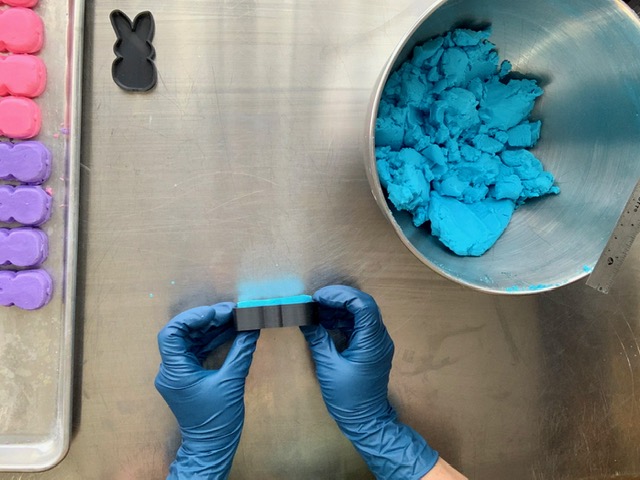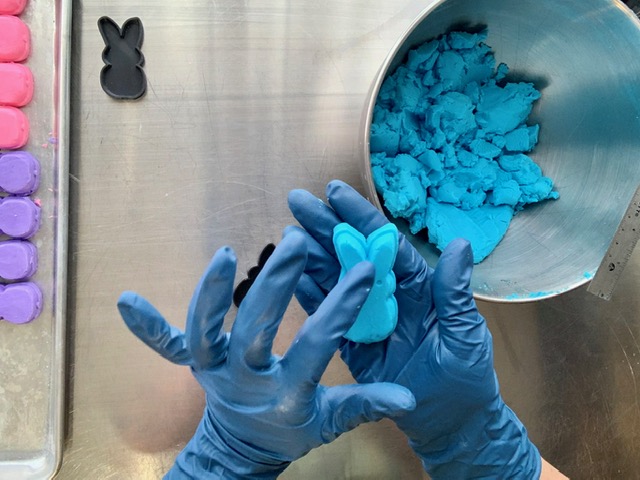I had never heard of bubble bars until a customer requested them a few years ago. Intrigued, I went out and purchased one from a major cosmetic chain. I was underwhelmed with the amount of bubbles, and consequently didn’t look into making them for another year.
The first thing I realized when I started making these bath treats myself was that the sales associate from the store hadn’t adequately educated me about the best way to use bubble bars. I was told to agitate mine by sloshing it back and forth from one cup to another, or to simply hold it in my hand under running water. The results were unimpressive. But now I know they work wonderfully when they are placed in a sieve and held under running water.
Educating your customers is paramount to product satisfaction. Whether you discuss the proper way to store handmade soap, or how to use bath bombs, your customers should walk away with enough knowledge to enjoy the product they purchase. Bubble bars are no different!
Before you educate your customers, however, you have to educate yourself! Bubble bars are essentially solid bubble bath. Most recipes start with a combination of liquid and powder surfactants, baking soda, and a binding starch or hardener. After that, every recipe varies, with some adding glycerin, polysorbate 80, liquid or hard oils, clays, and more.
What makes this recipe different from other bubble bars? Well for starters, most Bubble Bar recipes call for EPIC amounts of SLSA. This one uses a very small amount and pairs it with Bubble Up, or coco betaine. The next difference is that these do not use any glycerine. While not every bubble bar recipe calls for glycerine, many do. Glycerine is helpful in combating the drying effects of SLSA, but it can also cause your bars to stay soft. Even after months on my curing rack, some of the early recipes I tested NEVER got firm! And finally, the super smooth, pliable texture of this earned it the nickname of Bubble Fondant.
This Bubble Fondant has the wonderful ability to be used in conjunction with 3D printed molds, however the use of those molds must be modified. If you don’t have a 3D mold, or if you find the use of them to be too difficult, you can also use cookie cutters. For this project I used the Miniature Marshmallow Bunny mold from Cada Molds. I also highly recommend using a stand mixer.
As always, cover and secure your hair and wear gloves.I also recommend using a mask to prevent any irritation to your lungs when weighing dry ingredients.
Let’s dive in!
Bubble Fondant Recipe
Dry
- 616 g Baking Soda
- 35 g Cornstarch
- 10 g Cream of Tartar
- 40 g SLSA
- Dye/LAKE colorant (⅛ tsp Blue 1 LAKE)
Wet #1
- 35 g Bubble Up (Coco betaine)
- 20 g Avocado Oil
- 5 g Polysorbate 80
- 10 g Fragrance Oil (Warm Vanilla Sugar from Nature’s Garden)
Wet #2
- 42 g Cocoa Butter
Step 1: Sift all Dry ingredients into mixing bowl through mesh strainer, breaking up any clumps.

Step 2: Equip stand mixer with flat beater/paddle attachment. Cover with towel to prevent powders becoming airborne. Mix on low to allow all Dry ingredients to blend

Step 3: Weigh all ingredients from Wet #1 in a separate container and stir well. When mixture develops a creamy, gooey appearance, it can be added to Dry blend.

Step 4: Mix Dry/Wet #1 together on lowest setting for several minutes. It will look like wet sand.


Step 5: Meanwhile, weigh and melt the cocoa butter (Wet #2).

Step 6: Slowly drizzle the cocoa butter into the mixture while the beater continues to blend on lowest setting.

Step 7: Mix. Mix. Mix. Allow bubble fondant to mix for 3-5 minutes. Be patient! While the dough can be used as soon as it looks chunky, you’ll find it performs best when allowed to reach a smooth fondant texture. Resist the urge to speed things up by beating on a higher speed. It doesn’t help (I know–I tried!!!)
Step 8: Mix is ready when it looks like play-dough, retains its shape when squeezed, and doesn’t stick to gloves!

Let’s go over two ways to mold Bubble Fondant.
Using 3D Printed Molds to Mold Bubble Fondant
To successfully use 3D printed molds with this recipe you have to keep in mind that this is a bubble bar! I know that seems obvious, but one of the things I love about Bubble Bars is the delicious texture. You know, the crumbly texture that makes them look like ice cream when made into scoops, or gives them that decadent look when cut into slices? It’s the nature of a bubble bar to have cracks, and texture, so if you want a super smooth appearance you’ll have to get your mix to work with you instead of against you. Since it is moldable and chopable you can use that to your advantage!
For the Bubble Bunnies
Step 1: Place the detailed half of the 3D mold into the outer shell.
Step 2: Take a chunk of dough and shape to approximately the same size as mold.

Step 3: Smooth the chunk by rubbing it on a flat surface. Any wrinkles will show up on your bubble bar and be pretty hard to smooth out later, so this step is important

Step 4: Use a knife to trim the chunk. Make it smaller than the mold you want to use.

Step 5: If there are any detailed sections to your mold (ie, bunny ears) trim the area for that as well. This doesn’t need to be exact–a very rough approximation is fine. The most important thing is that the piece is laid in fairly flat and won’t be bent when more dough is added

Step 6: Lay trimmed piece into mold and overfill with extra dough
Step 7: Using a knife, trim the dough flush with the shell.

Step 8: Press the mold half free from the mold shell

Step 9: GENTLY and evenly wiggle one section of the bar free at a time. Be delicate and patient.

Step 10: Allow bars to dry for 24-48 hours. The longer they dry, the better, however mine were ready to package within 24 hours!

This recipe made 16 Bubble Bunnies each weighing approximately 1.5 ounces. Using 1 gave me plenty of bubbles and fragrance, but I used up to 3 at once and had mounds of bubbles, with completely hydrated, happy skin.

Using Cookie Cutters to Mold Bubble Fondant
If you don’t have 3D Printed Molds, you can still use this recipe to make Bubble Cookies! All you need are regular cookie cutters and some cling wrap!
Step 1: Take a chunk of dough and shape it into a ball slightly larger than your cutter.
Step 2: Place the chunk on one side of cling wrap, and fold the other side on the top of the bubble dough.
Step 3: Use your fingers to smooth the dough out.

Step 4: Press the cutter into the dough OVER the cling wrap. This will create a domed shape as the cling wrap puts pressure on the dough.

Step 5: Uncover and add trimmed edges back to main mix.

Step 6: Gently peel away from cling wrap and allow to dry.

Congratulations, you’ve made Bubble Bars, or bubble cookies! Make sure to share your creations on Facebook or Instagram so we can see the amazing things you make!
About Robyn French Smith

My name is Robyn French Smith! I studied fine art at the University of St Thomas and the Glassell School of Art in Houston TX, and graphic design at The Art Institute of Houston. I started dabbling in DIY bath and body products over 10 years ago after moving to Alaska. While I knew how to make basic soap for several years, I didn’t start looking at it as an art form until about 4 years ago when a neck and shoulder injury made it almost impossible for me to draw and paint. I needed a place for all that creativity to go, and I found it in soap. I received my Basic Soapmaker Certification from the HSCG in 2019 and plan on pursuing further levels of certification.
Find me online at scandaloussoap.com and Facebook!










How long does it take them to dry?
Can we use wonderbar instead of the fondant for the bubble portion?
Hey, I made them according to the recipe, it went well, looked exactly like yours at every stage but when I use them in the bath they don’t make bubbles, any idea what I’m doing wrong? I tried holding it under the tap, then I put it in a sieve and no bubbles. The only thing I changed is I swapped avocado oil for sweet almond since I didn’t have any but this shouldn’t affect bubbles?
There is way too much cocoa butter, & oils will all stop bubbles. There is not much surfactant in (slsa & coco betaine)
There isn’t even 5% SLSA in this formula, requires 15-20%. I can get amazing bubbles with a greater percentage of oils than this formula using 20% SLSA, the coco betaine isn’t going to produce bubbles like SLSA does. I don’t believe this formula can produce what it claims.
Can you please share the steps of designing the bath bomb mould for an image to a 3D file? My neighbour who is into making her own bath bombs asked me to make her one and I would like to know how it is done. Would greatly appreciate it. Thanks for sharing.
Hello! We do not make bath bomb molds!
I have a couple questions before starting this project ?
#1 Can I keep left over fondant be stored in a ziplock bag for later use.
#2 Does the fondant get hard ?
Think about using this recipe to form roses and flowers for bath bombs
Where can you find bubble up. I’ve looked and can’t find it
Hello! It will be called cocamidopropyl betaine, or you can use your favorite liquid surfactant.
I dont know if u found any Bubble Up but if ur having issues finding it in stock
Wholesale Supplies Plus usually has it in stock and they have Free s?h w/$25.00 purchase and it doesnt take long to have a $25.00 order now days. I hope this helps. Sandra
I made this exactly and not many bubbles at all. I bought the wonderbar recipe, will it produce bubbles?
Why do people make tableted product like this at all, if the user’s just going to have to granulate it for best results? Why not make a granular or powdered product? Is the bar just considered neat for packing or shipping? Is it because people have trouble making and keeping granular product uniform? Is it because users would get a powdered product lumpy anyway after exposure to humidity or drips in the bathroom? (That was a problem with the bubble bath powders that were common 60 years ago.)
I could understand if instead of making crumbly product you were making a bar that held together and was reusable after dipping it and dissolving some of it in a bath, like a cake of soap.
This item as well as wonderbars/bubble rolls are multi use if youre doing it right, you could get a couple baths out of one item when formulated right. Powdered/granular products arent for everyone, people with motor skill or respiratory issues (at least my customers) lean away from anything like that; plus holding it under running water (by hand or bathbomb holder) is quick and easy than measuring